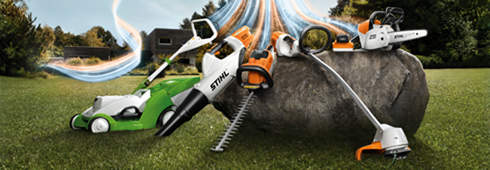Responsibility
Products with built-in environmental protection

Ecology and high technology go hand in hand at STIHL. The development of new technologies and products is always driven also by increased ecological requirements. Energy consumption, exhaust emissions and noise, as well as users' health and safety, have been important criteria for our product development for many decades. STIHL repeatedly sets new standards worldwide with the development of environmentally compatible engine technologies.
-
BioPlus, 1985
The plant-based saw-chain oil is biodegradable on the forest floor within a very short time. It was awarded the Blue Angel environmental prize as well as the European Ecolabel.
-
Ematic, 1987
Due to the special construction of the guide bar and chain, each drop of oil gets to where lubrication is needed. This reduces oil consumption by up to 50%.
-
KAT, 1988
The world's first series-production catalytic convertor for two-stroke engines minimizes the unburnt components of exhaust gases so that emissions of damaging hydrocarbons are reduced by up to 80 percent.
-
Filling system, 1989
The filling system allows no-drip refueling of chain saws and other outdoor power equipment – and it stops automatically when the tank is full. This reduces fuel consumption and also protects the environment from leaking or overflowing gasoline.
-
MotoMix, 1990
This ready-mixed two-stroke fuel is largely free of substances hazardous to the health such as lead, sulfur, aromatic hydrocarbons and benzene. Its high octane value ensures optimal power delivery from the engine combined with low fuel consumption.
-
Quiet mowing line, 1990
A spiral groove on the quiet mowing line prevents high-frequency sounds that are unpleasant for the ear and which occur when the nylon line rotates. The spiral groove reduces the line's sound emissions by 15 decibels and facilitates environmentally compatible work.
-
Guide bars with water-based paint, 1995
The use of water-based paint reduces solvent emissions by 90 percent thanks to mixable pigments.
-
Quiet chain saw, 1995
The STIHL MS 023 L, the world's quietest chain saw, was awarded the Blue Angel environmental prize together with the STIHL E 14 C electric saw.
-
Organic oil HTPlus, 1998
Thanks to synthetic lubricating components, HTPlus organic oil is quickly biologically degradable and therefore environmentally compatible.
-
VIKING Motoplus, 1999
The fuel developed especially for four-stroke engines reduces the harmful potential of exhaust emissions and is almost free of benzene. In addition, smoke-free combustion protects valves and cylinders while increasing the engines' lifetime and performance.
-
Low-emission 4-MIX engine, 2002
Due to combustion of fuel with very little residue, fuel savings of up to 20 percent, and thus also of CO2 emissions, are possible.
-
Economical 2-MIX engine with scavenging, 2004
Scavenging primarily prevents the unburnt fuel-air mixture from escaping into the environment with the exhaust emissions. As a result, up to 20 percent fuel is saved and emissions are reduced by up to 60 percent.
-
Low-emission and quiet blower, 2005
With the new 4-MIX engine, the new blower operates with lower noise and is environmentally friendly due to its low-emission and low-noise technology.
-
Intelligent engine management, 2007
This innovative system automatically regulates a tool's full-load mixture and maximum engine speed. This in turn ensures optimal engine performance and increased environmental compatibility.
-
Battery technology, 2010
The cordless models from STIHL and VIKING operate quietly and free of emissions, and allow unlimited freedom of movement.
-
Four Angels for STIHL, 2011
Four cordless tools have already been awarded the Blue Angel environmental prize for products that have low levels of pollutants and are environmentally friendly and health friendly: the cordless hedge trimmers STIHL HSA 65 and HSA 85, the cordless grass trimmer STIHL FSA 65 and the cordless chain saw STIHL MSA 160 C-BQ.
-
EC engines with high efficiency, 2011
The STIHL electric motor (EC) not only gets up to 55 percent more power from the battery – due to its wear-free operation, it also increases average battery lifetime by up to 70 percent.
-
Electronic fuel injection, 2011
This new technology ensures maximum starting comfort, optimal engine performance with excellent running and accelerating properties, and low exhaust emissions. Although fuel consumption is reduced by 15 percent, this innovation increases engine power by 20 percent.